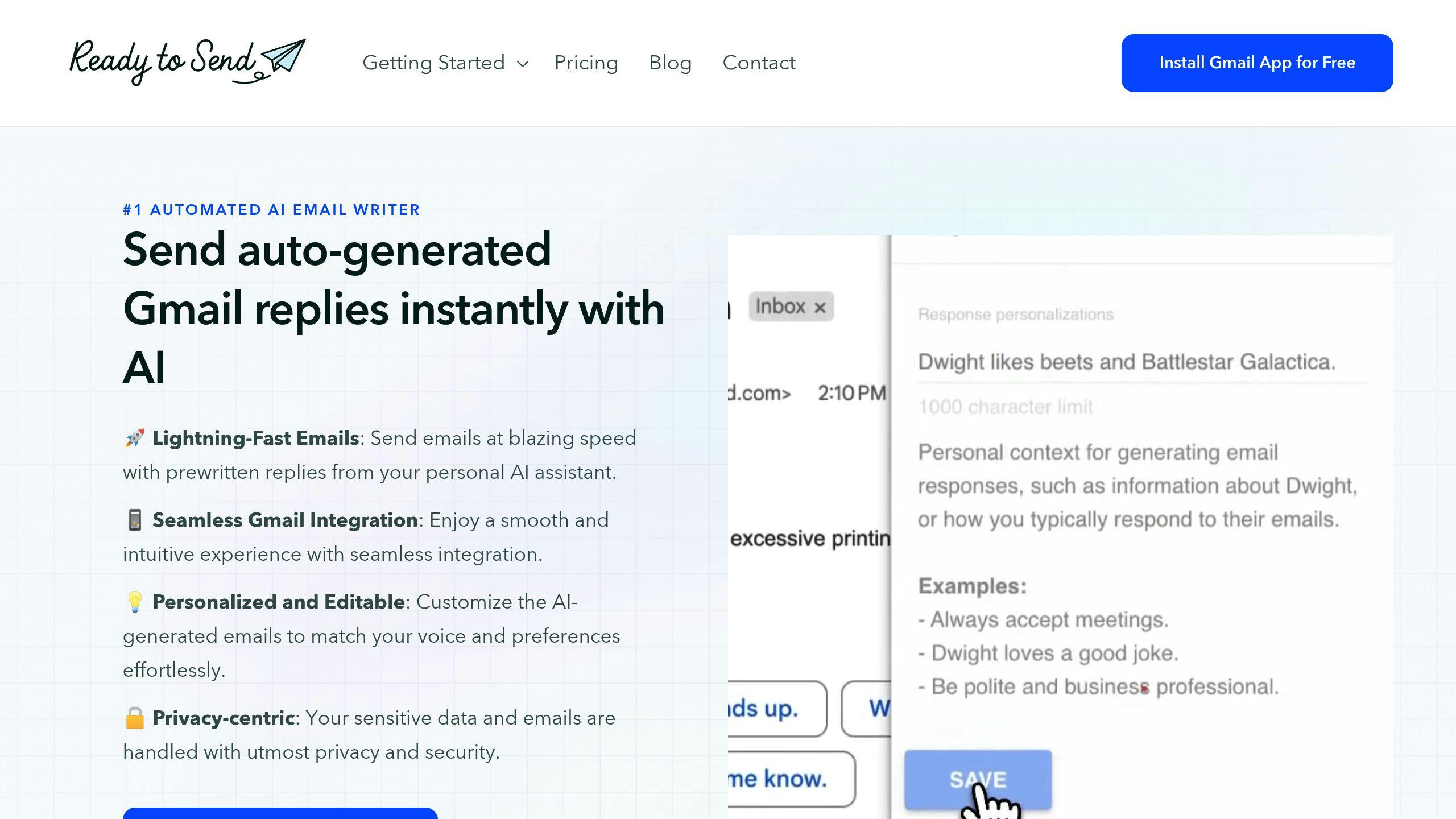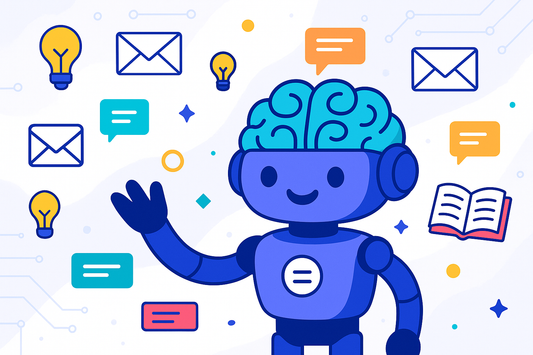Managing emails takes up 28% of your workweek - about 13 hours. With over 347 billion emails sent daily (2023 data), inbox overload is a massive challenge. But AI tools can help you save time, reduce clutter, and prioritize what matters.
Key Takeaways:
- Workers handle 126 business emails daily, but only 10% are critical.
- AI tools like SaneBox, Mailman, and Google Gemini cut email processing time by up to 20-30%.
- AI email drafting tools improve productivity by 40%, crafting tailored responses quickly.
Quick Comparison of AI Email Tools:
| Tool | Key Feature | Cost |
|---|---|---|
| SaneBox | Auto-organizes emails | From $7/month |
| Mailman | Schedules email deliveries | $10/month |
| Shortwave | Syncs with Google Calendar | $8.50/user/month |
| Ready to Send | Personalized email drafts | Usage-based |
AI-powered automation helps you spend less time on emails and more on meaningful work. Ready to regain control of your inbox? Let’s dive in.
How to use Gemini AI with Google Workspace
AI Tools for Email Sorting
AI email sorting tools make managing overflowing inboxes easier, turning tedious manual tasks into streamlined, automated processes tailored to your habits. These tools help professionals save time and focus on what matters most.
How AI Email Sorting Works
AI uses algorithms to analyze email content and context. It sorts messages based on factors like sender, content, and your interaction patterns. This automated system prioritizes important emails while neatly organizing less critical ones, so you can tackle your inbox without the clutter.
Comparing AI and Manual Email Sorting
AI sorting offers clear advantages over traditional methods. Here's how they stack up:
| Aspect | Manual Sorting | AI Sorting |
|---|---|---|
| Time Spent | 13 hours per week | 4-5 hours per week |
| Accuracy | Prone to human error | Over 90% accuracy |
| Consistency | Varies | Always reliable |
| Learning | None | Learns and improves |
A McKinsey study found that organizations using AI email management solutions saw a 20-30% productivity boost [2]. This is thanks to quicker email processing and fewer disruptions during the day.
Popular AI Email Sorting Tools
Here are some standout tools designed to handle email overload:
Shortwave ($8.50/user/month)
- Syncs with Google Calendar for easy scheduling.
SaneBox (Starting at $7/month)
- Automatically organizes emails into folders with advanced prioritization.
Mailman ($10/month)
- Schedules email deliveries intelligently.
Once your inbox is under control, you can explore AI tools for drafting and managing emails more effectively.
AI Email Writing Tools
Managing your inbox is just the first step. The next challenge? Responding to emails efficiently. This is where AI email writing tools come in. These tools help automate email drafting, saving time and letting you focus on more important tasks.
How AI Writes Emails
AI email tools use advanced algorithms to analyze language and context, creating responses that feel personalized and relevant. They take into account:
- Context and tone of the conversation
- Details about the recipient
- Common response patterns
- Past interactions with the recipient
According to Maestrolabs, these tools can improve email productivity by up to 40% [2]. Plus, they adapt to your writing style, making sure your emails stay consistent and sound like you.
Tips for Using AI Email Writers
Want to get the most out of these tools while keeping your emails personal? Here are some key practices:
| Best Practice | Why It Matters | How to Do It |
|---|---|---|
| Review Before Sending | Avoid errors and mismatched tone | Always double-check AI-generated emails for accuracy and context. |
| Customize Templates | Add a personal touch | Include specific details and tailor responses to the recipient. |
| Define Parameters | Ensure quality and alignment | Set clear guidelines for tone, length, and key points. |
| Provide Feedback to AI | Improve future responses | Teach the AI your preferences by offering corrections or suggestions. |
Ready to Send: Features and Use

If you're looking for a tool designed specifically for Gmail users, Ready to Send is worth checking out. It automates personalized email drafts, supports multiple languages, and offers customization options. With a free trial and usage-based pricing, it’s accessible for a range of needs. Plus, Setapp AI+ subscribers can use it as part of their plan, with monthly limits varying from 10 to 250 emails depending on the subscription.
For more options, tools like WriteSonic and MailerLite cater to various email needs - from quick replies to detailed business communications [2]. Pairing AI tools with human oversight ensures your emails remain polished and professional.
sbb-itb-cd77960
Gmail Automation Tools
Gmail offers a range of tools to help you manage email overload and streamline your inbox. By using these features effectively, you can save time on repetitive tasks and keep things organized.
Setting Up Gmail Filters
Gmail filters allow you to automatically manage incoming emails based on specific criteria. Here’s how to set them up and make the most of them:
How to Create Filters
- Use Gmail’s search bar dropdown to set criteria like sender, subject keywords, or specific phrases.
- Select actions for emails that match your criteria:
| Action | What It Does |
|---|---|
| Skip Inbox | Sends newsletters and updates directly to specific folders. |
| Apply Label | Organizes emails by project, client, or category. |
| Forward | Automatically shares emails with team members. |
| Delete | Removes unwanted promotional or spam content. |
| Mark as Read | Clears routine notifications without manual review. |
Once filters are in place, you can rely on Gmail’s other features to further optimize your workflow.
Priority Inbox
Gmail uses AI to identify and sort important emails into a dedicated Priority section. You can refine this by marking emails as important or unimportant, helping the system learn your preferences over time.
Time-Saving Gmail Features
Gmail includes several tools designed to cut down on time spent managing emails:
- Smart Compose: Predicts and suggests text as you type, potentially saving users up to two hours each week.
- Templates: Enable Templates under Settings > Advanced. Once activated, you can create and reuse templates from the compose window menu.
- Smart Reply: Provides three quick, context-aware responses. You can tweak these to ensure they match your tone.
- Snooze: Temporarily hide emails until a specific time. This is great for handling non-urgent messages without forgetting them.
"Automating Gmail tasks eliminates repetitive actions." - Clean Email Team
Managing AI Email Tools
Effectively managing AI email tools can simplify workflows while safeguarding sensitive information. Striking this balance ensures productivity without sacrificing security or the personal touch in communication.
Email Security and Privacy
When selecting AI email tools, security should be a top priority. Professionals spend an average of 2.5 hours daily managing emails, making secure automation solutions a must [1].
Key Security Features to Consider:
| Feature | Purpose | Example Implementation |
|---|---|---|
| Encryption | Safeguards sensitive information | SaneBox's end-to-end encryption |
| Two-Factor Authentication | Prevents unauthorized access | Google Gemini's integrated security |
| Data Handling Policies | Promotes transparency | Ready to Send's privacy-focused approach |
| Access Controls | Regulates user permissions | MailerLite's role-based access |
Configure your AI tools to handle only the data they need, like filtering out unwanted senders, while keeping sensitive information secure [1].
Once security is addressed, the next step is ensuring your emails remain personal and engaging, even when automated.
Keeping Emails Personal with AI
AI tools like WriteSonic offer customizable templates to combine efficiency with a personal touch [2]. Balancing automation with a human element is essential for effective email communication.
Tips for Adding a Personal Touch:
| Approach | Implementation | Benefit |
|---|---|---|
| Tone Customization | Use Ready to Send's voice-matching feature | Maintains consistent communication style |
| Selective Automation | Automate routine tasks only | Leaves room for personal attention on key messages |
"The key to successful email automation isn't just about efficiency - it's about enhancing human connection through technology while maintaining security", says Brad Miller, founder of Ready to Send.
Tools like SaneBox help prioritize and customize email handling, reducing overload while keeping communication standards intact. Their service, available for as little as $0.07 per day, offers a practical solution for managing email chaos [1].
Pro Tip: Regularly check and fine-tune the settings of AI tools like Lindy or Flowrite to ensure they align with your communication style and security needs [4].
Conclusion: Next Steps for Email Automation
Managing emails remains a major challenge, with professionals handling over 121 emails daily and spending around 13 hours each week on their inboxes [3]. AI-powered email automation offers a way to save time and stay productive.
Getting Started with Email Automation
The first step is choosing tools that match your workflow and security needs. Start small by using basic features from trusted providers. As you grow more familiar with the tools, you can add more advanced automation features to your setup.
Key Implementation Steps
| Phase | Action | Expected Outcome |
|---|---|---|
| Assessment & Selection | Identify pain points and select tools | A clear plan with the right solutions |
| Integration | Connect tools to your current email system | A smoother, automated workflow |
| Optimization | Track performance and tweak settings | Improved efficiency over time |
"The integration of AI with email clients like Gmail will become more seamless, making it easier for users to adopt these tools and enhance their productivity", says Brad Miller, founder of Ready to Send.
Measuring Success
To see if your automation strategy is working, keep an eye on these metrics:
- Time spent managing emails
- Faster response times
- Less clutter in your inbox
- Accuracy of AI sorting and categorization
Tracking these will help you ensure your automation efforts continue to deliver value.
Security Considerations
When choosing automation tools, focus on those that offer:
- Strong encryption
- Secure data storage
- Transparent privacy policies
- Regular updates to address security risks
The future of email management is all about using smart automation to save time while staying secure. By adopting AI-powered tools, you can not only streamline your inbox but also regain focus and create a more productive workday.
FAQs
Does Gmail have an AI assistant?
Yes, Gmail integrates Google Gemini, an AI-powered tool designed to make email management easier. It offers features like smart replies, auto-drafting, and tone adjustments to help users communicate more effectively.
Gmail's AI operates securely within Google's infrastructure, ensuring privacy. While Gmail includes basic AI tools, third-party solutions can add extra functionality, such as:
- Better email organization
- Custom filtering options
- Automated follow-up reminders
"The integration of AI with email clients like Gmail will become more seamless, making it easier for users to adopt these tools and enhance their productivity", says Brad Miller, founder of Ready to Send [2].
Considering professionals handle an average of 121 emails daily [3], combining Gmail's AI with specialized tools creates a strong system to manage inbox overload. The trick is to choose tools that address your unique email challenges while staying secure and efficient.
For example, pairing Gmail's AI with services like SaneBox or Mailman can help reduce inbox clutter and improve productivity. This blend tackles email overwhelm while keeping communication organized and effective.





